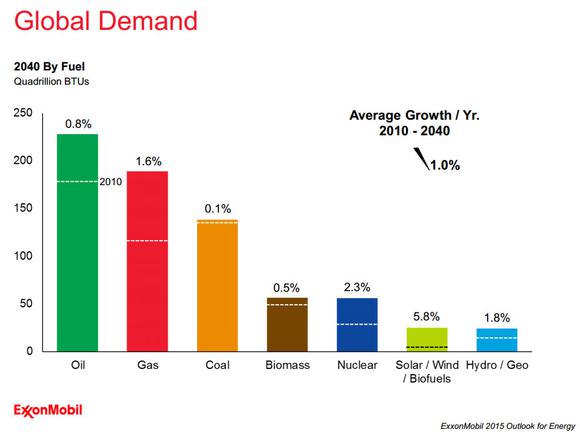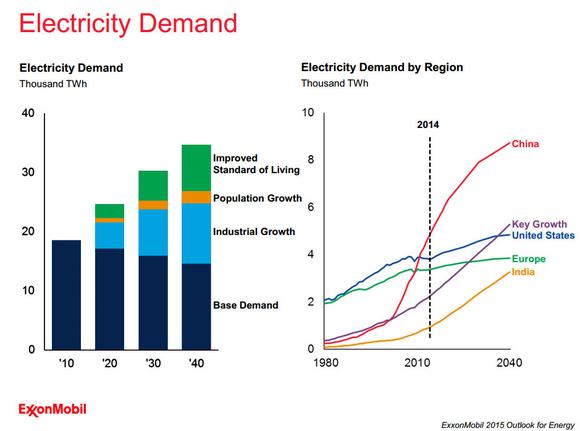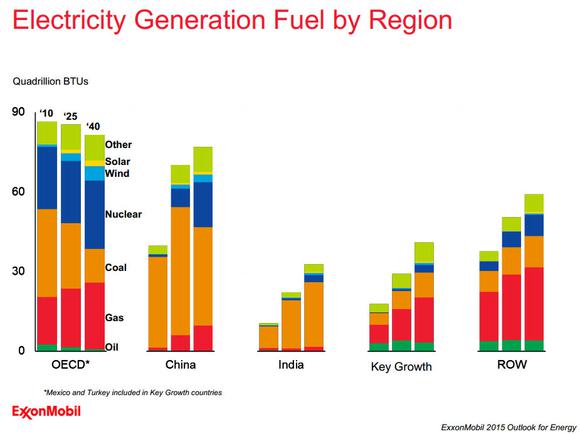ExxonMobil (XOM 0.28%) recently updated its energy outlook through 2040. That outlook suggests that energy demand will grow by an average of 1% per year. The biggest driver of new energy demand is expected to come from electric power generation, which would suggest a bright future for coal as it's a key fuel source for power plants. However, that's simply not expected to be the case as coal is not only expected to be unseated as the world's number two fuel source by natural gas, but will endure anemic growth in the years ahead as we see in the slide below.

Source: ExxonMobil Corporation.
As that chart illustrates, demand for coal is expected to only grow by 0.1% per year and is being displaced by not only natural gas, but by wind, solar and nuclear. Here's a closer look at why its outlook is so dim and what that means for coal stocks.
A dim outlook for coal
Growth from emerging economies is expected to be robust in the years ahead and will more than offset declining energy demand in developed nations, which are focusing on energy efficiency to curb their energy appetite. We see this in this slide below.

As you can see, base demand for electricity is expected to fall. However, industrial growth and an improved standard of living in emerging economies will still drive strong electric demand growth in the years ahead. While China and India are well known emerging market growth drivers, there are other emerging economies like Mexico and Turkey that are key growth economies for new electric demand. In fact, these economies are the key growth drivers for new natural gas demand in the decades ahead as we see in the following slide.

Source: ExxonMobil Corporation.
Not only is natural gas important to key growth nations, but as that slide shows it is expected to displace coal in developed nations. Given the desire to cut carbon emissions, these nations are turning toward cleaner burning natural gas, which is squeezing coal out of the equation. The other reason gas is expected to win is because it is cheaper to build new natural gas power plants than most other electric generation options, allowing nations to invest less money, yet still deliver much needed power to their citizens.
Meanwhile, demand for coal in China is actually expected to start to decline by 2040 after growing through 2025. Here, again, coal will be displaced by natural gas, as well as nuclear and other cleaner power sources. The only bright spot for coal is India, which will see most of its new electric demand powered by coal. That said, India's growth still isn't big enough to really move the needle for coal demand.
What this means for coal stocks
Clearly, this outlook isn't good for coal miners over the long term. That being said, in the short term, there's still strong demand growth for coal in China as well as India. Because of this, miners like Peabody Energy (BTU +0.00%) and Arch Coal (NYSE: ACI) will need to continue to focus on accessing these coal growth markets.
This is a case where Peabody Energy is already ahead of the game as it acquired coal deposits in Australia in 2011 to put itself closer to customers. This is a competitive advantage over its other U.S. rivals because it can save on shipping costs.
That's not to say American coal exporters are at a total loss. U.S. coal exports have increased in recent years to take advantage of this demand in Asia. Still, its not as easy for U.S. producers to export coal as there is a lot of opposition to coal export terminals, especially along the West Coast of the U.S. Environmentalists are working to slow demand for coal even more by making it more expensive to ship. This could prove to be a problem down the road as export capacity is limited. However, coal companies like Arch Coal, which owns an equity stake in a West Coast coal export terminal where it exports coal, are working to gain greater access to exports by looking to increase capacity at current sites. Even with this capacity, Arch, and its peers, still face an uphill battle to make money on coal given the near complete lack of demand growth.
Investor takeaway
The future of coal isn't very bright. Its growth prospects remain very limited as demand is only expected to grow 0.1% per year for the next few decades. Because of that the industry is going to have to focus on where that growth is expected to come from in order to offset declines in demand from virtually everywhere else. It's an uphill battle to say the least, which will make it really tough for coal stocks to deliver much value for investors.